Germany Warns Of Cyber Attacks By Russia, Iran, China

The new head of the German Federal Office for Information Security (BSI) warned of a growing threat from Russian, Iranian and Chinese cyber-attacks.

The new head of the German Federal Office for Information Security (BSI) warned of a growing threat from Russian, Iranian and Chinese cyber-attacks.
In an interview with Süddeutsche Zeitung on Thursday, Claudia Plattner said the threat situation in the network is "bigger than ever". Germany as a European power and supporter of Ukraine is an "attractive target" for hacker groups, she added.
"The goals are espionage, destabilization and influence," said Plattner, who took office on July 1. “An increase in the number of attacks can also be observed from China and Iran.”
The German security authorities are concerned that pro-Russian activists, cybercriminals, and hacker groups from the Russian secret services are joining forces to attack Western systems, the report added.
Recently, websites of authorities and other important institutions have been paralyzed repeatedly. Many experts regard the fact that 5,800 wind turbines in Germany failed last spring as a result of a suspected Russian hacker attack.
The BSI head also called for the critical infrastructure in Germany to be better protected. Solutions are needed to "stop and fend off" attacks, she told Süddeutsche Zeitung, "just holding your hands up is not enough."
Federal Interior Minister Nancy Faeser (SPD) plans to give the Federal Criminal Police Office more powers so that it can actively defend against a hacker attack. Details of the plans are not yet known, but experts warn of the risks of interfering with third-party systems.
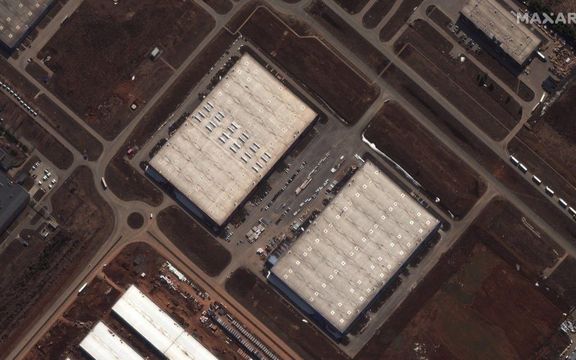
Russia is importing Iranian expertise for its drone factory being built to manufacture Russo-Iranian drones.
The factory in Russia’s Republic of Tatarstan, will be fully operational as early as next year, with recruitment in full force.
Several of the jobs posted since April for the site are seeking Farsi speakers, based on research by Airwars, a conflict monitoring group based at Goldsmiths, University of London.
The Iranian interpreters will be required to travel, perform simultaneous translation and translate technical documents, according to a report in the Financial Times.
Located in a business park near the town of Yelabuga, Moscow has converted an agricultural unmanned aerial vehicle maker to supply its war effort in Ukraine. Images show the vast complex is well underway.
Albatross, the company operating on the site has produced reconnaissance drones for President Vladimir Putin’s defense ministry, with roughly 50 delivered for combat in eastern Ukraine.
The factory is at the center of an expanding tech partnership with Tehran, whose expertise Moscow has relied on to establish a domestic drone-building capability to support its invasion and further skirt western sanctions.
Samuel Bendett, an expert on autonomous weaponry at the Center for Naval Analyses, told the Financial Times: “If Russia wants to do something covert with Iran, this is an advantageous location. It’s on the river that flows into the Volga, so you can bring parts by ship from Iran covertly.”
Iran has supplied Russia with hundreds of Shahed “kamikaze” loitering drones, which have been flown in swarms into Ukrainian infrastructure and neighborhoods. The investigation by FT and Airwars have not, however, found proof that a Shahed drone is being manufactured at the plant.
According to US intelligence, Moscow has procured hundreds of the suicide drones from Tehran. The White House claimed Alabuga was a still-expanding industrial site where an Iranian-Russian drone plant could become fully operational early next year.
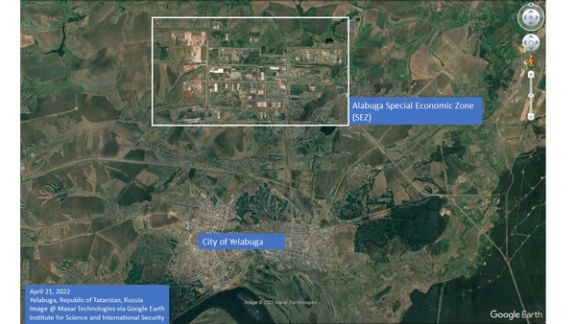
Photos and videos from Russian social media and local media outlets indicate Albatross commenced some drone production at the site in January. Albatross described itself as a maker of commercial drones for agricultural purposes and mapping.
Iran’s drone program has been growing steadily since the 1990s. Bendett, from the Center for Naval Analyses, said: “The Iranians already have a mature, proven technology. Iranian drones are in that sweet spot between those very expensive drones that can range very far and those smaller drones that don’t fly more than 100km. It’s a fairly sophisticated enterprise.”
Iran has supplied UAVs to proxies and partner countries since the early 2000s, both through direct weapons transfers and through the provision of UAV assembly kits. Venezuelan president Nicolás Maduro confirmed in 2012 that his government bought drone manufacturing technology, as well as infrastructure, from the Iranian regime.
Iran’s foreign ministry spokesperson, Nasser Kanaani, last month said the Islamic republic had not provided any sides at the war with weapons and called the allegations “politically motivated”. “Those who make these claims have not shown any evidence to prove their claims,” he said.

Amid reports of imminent gasoline price rises and rationing in Iran, the regime has put an unknown number of fuel stations on security alert.
According to Iran International sources, regime security organizations including the Supreme National Security Council, have identified sensitive and strategic gas stations vulnerable to riots and conducted security drills in the middle of the night.
In November 2019, a government decision to increase fuel prices by 50–200 percent triggered a cycle of protests and unrest across the country that lasted for over two weeks. During this time, angry protesters and suspected government provocateurs torched hundreds of gas stations, banks, and government buildings.
One of the main reasons that the Islamic Republic has not managed to increase prices in the midst of the current economic crisis is its being engrossed in the worst wave of unrest in years following the death in custody of Mahsa Amini in September. Fuel price rises risk fanning the flames of unrest further.
The regime, which has one of the world's largest oil and gas reserves, sells gasoline at extremely low, subsidized prices, charging less than 10 US cents per gallon, or less than 3 cents per liter, while neighboring oil-producers have much higher prices, in line with international market rates. Second only to Venezuela, Iran has the world’s cheapest gasoline price.
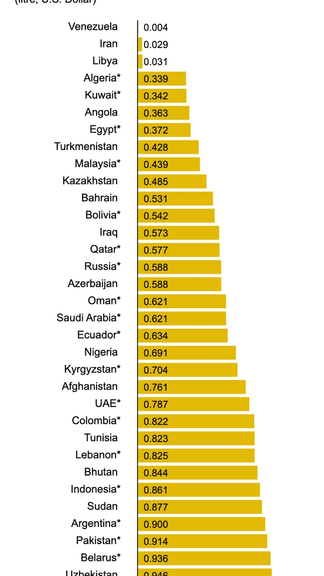
For years there has been talk of adjusting prices, but since 2018 Iran’s currency has dropped 12-fold and any increase needs to be huge to be meaningful in US dollars.
As part of the new plan, which has been piloted in a number of small cities, citizens are still allowed to buy 60 liters (15.8 US gallons) of gasoline per month at the cheap price of 15,000 rials per liter, or less than 3 US cents. The new regulation reportedly caps the more premium gasoline at 150 liters (40 gallons) per individual per month.
There are conflicting reports about the timing or the exact details of the new plans with unconfirmed reports that the new regulations will take effect gradually and some others claiming that there will not be any cap on the more expensive gasoline.
Hossein Aghayan, a former director of the supply department of the National Iranian Oil Refining and Distribution Company, said a major worry for the regime now is controlling the supply chain to prevent lines forming at gas stations across the country.
In addition to extremely low prices that do not encourage saving fuel, Iran also faces gasoline and diesel shortages due to a lack of refining capacity. The low prices also lead to millions of liters of fuel being smuggled out of Iran daily, part of a large-scale global smuggling network.
Iran’s heavy subsidies for fuel and electricity cost the country at least $50 billion a year, while the government struggles to secure foreign currencies amid US economic sanctions.
In March, Iran International revealed a classified document outlining the proceedings of a meeting at the presidential office in late February which revealed that strategic fuel reserves being at a dangerously low level, forcing major repairs at refineries to be delayed allowing maximum production for the time being. Officials were told to avoid any public remarks or suggestions that could be interpreted as an intention to raise current fuel prices for fear of inflaming public discontent.
While the country is hugely dependent on the revenues from crude oil exports, due to sanctions and mismanagement, it has failed to modernize the energy sector in general, with power shortages most of the year. Systemic corruption also further cripples the weak system. The situation has been grave in recent years but since the administration of Ebrahim Raisi assumed office in 2021, the entire energy management system is going haywire even faster, drawing backlash from not only the public but even regime officials.

The UK government has introduced sanctions on more than a dozen more Iranian individuals and entities over human rights violations.
The list of 13 individuals and entities responsible for human rights abuses in Iran, released by the UK Foreign Office on Thursday, includes prison governors overseeing torture and inhumane treatment and organizations charged with collecting private information of regime opponents.
It also covers individuals leading the repression of women through Iran’s compulsory hijab laws, according to a statement by the UK government.
The sanctioned individuals include Abdolhossein Khosropanah, the secretary of Iran's Supreme Council of the Cultural Revolution; Mohammad-Amin Aghamiri, the secretary of Supreme Council of Cyberspace; and Moslem Moein, the chief of the IRGC's Basij Cyberspace Organization.
The IRGC's Cyber Defense Command (CDC) which monitors the emails, websites and online activities of regime opponents, and the Supreme Council of the Cultural Revolution (SCCR) which sets Iran’s policies on cultural and educational matters, including wear of the hijab were also sanctioned by the UK government on Thursday.
"Today the UK has sent a clear message to the regime – we will not tolerate this malign behavior and we will hold you to account," said UK Foreign Secretary James Cleverly in a statement.
"Our new sanctions regime will help to ensure there can be no hiding place for those who seek to do us harm," he added.
Cleverly also said that "the Iranian regime is oppressing its own people, exporting bloodshed in Ukraine and the Middle East, and threatening to kill and kidnap on UK soil."
The Islamic Republic has, in the past few years, been found to have attempted to carry out terror acts on UK soil, including plots to kidnap Iran International journalists, which forced the TV channel to relocate its activities from the London office to Washington DC due to the UK’s inability to protect its citizens on its soil.
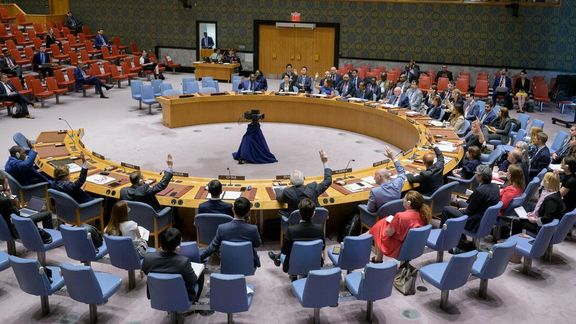
As the UN Security Council held a session on Iran, Britain says it is mulling over a new sanctions regime giving it greater powers to target the regime’s decision makers.
The Thursday session was held to brief the Council on the Joint Comprehensive Plan of Action (JCPOA) and the implementation of resolution 2231, whose clauses are justifying the UK, France and Germany retaining ballistic missile sanctions set to expire in October under the defunct 2015 nuclear deal.
Member states argue that both Iran and Russia have violated their obligations under UN Security Council Resolution 2231 by participating in the transfer of UAVs without obtaining advance approval from the UN Security Council. The United States, France, Germany and the United Kingdom say the arms supplies breach a clause of the resolution, justifying the possibility of snapback, under which multilateral sanctions would come back onto Tehran.
Resolution 2231 is a 79-page document submitted at the time by the US – S/2015/546– that listed categories of weapons needing prior Security Council approval. S/2015/546 refers to drones “capable of delivering at least a 50kg payload to a range of at least 300km,” and while Iranian-made drones can have a range of over 1,000km they carry a slightly lighter payload. There would be a clearer violation if Iran transferred Fateh-110 and Zulfiqar missiles.
US envoy to the UN Robert A. Wood said at the session that Washington remains gravely concerned with “Russia’s use of Iranian drones against Ukrainian cities and civilian infrastructure in its unprovoked war against Ukraine.”
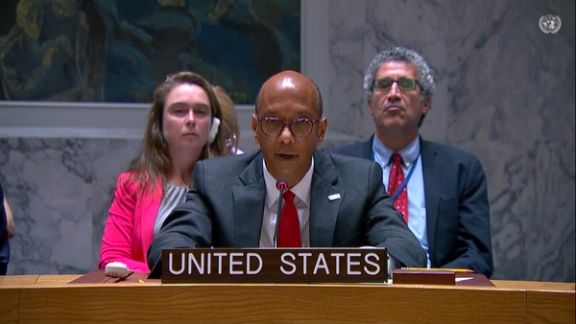
He said Russia’s use of Iranian-made Shahed-136 drones must be investigated as it clearly constitutes a violation of UN Security Council Resolution 2231, Annex B, Paragraph 4, urging the council to send teams of investigators to Kyiv to examine the debris from these weapons and to review material recovered by the United Kingdom.
“It is no secret that Iran’s UAV development and proliferation pose a global threat. That is why the transfer of these items was prohibited under 2231,” he added, noting that despite proof of Iran’s complete disregard for its obligations under Resolution 2231, Tehran continues to deny its role in the damage caused by its weaponry in Ukraine.
The US called on the Council to address “any and all violations of Resolution 2231 given the implications for not only peace and security in the Middle East, but also in Ukraine and the rest of the world,” reiterating “calls for the Secretary-General to update the Council on his assessment of Iranian made UAVs recovered in Ukraine within the next 30 days.”
He also referred to Iran’s test of a medium range ballistic missile in May, saying that the launch was inconsistent with “paragraph 3, which calls upon Iran not to undertake any activity involving ballistic missiles designed to be capable of delivering nuclear weapons, including launches using such ballistic missile technology.”
“Iran’s ballistic missile activity – especially in light of Tehran’s nuclear ambitions and its threatening rhetoric – is an enduring threat to regional and international peace and stability,” he said, stating that even after certain restrictions in Resolution 2231 terminate, the United States will continue to take vigorous measures to counter this threat and block the proliferation of sensitive ballistic missile-technology to and from Iran.
Rosemary A. DiCarlo, the UN Security Council’s Under-Secretary-General for Political Affairs, said that the council “examined information related to paragraph 4 of annex B,” pertaining to the supply, sale or transfer to or from Iran of all items, materials, equipment, goods and technology.

She added that they received information from the United Kingdom about ballistic missile parts seized by the British Royal Navy in February 2023, in international waters in the Persian Gulf.
“The United Kingdom shared imagery of the seized components and its analysis that the components were of Iranian origin and transferred in a manner inconsistent with resolution 2231,” she said, adding that France, Germany and the United Kingdom also conveyed their view that some of the seized components are controlled items listed in the Document S/2015/546 and that their transfer without prior approval of the Council was therefore inconsistent with the resolution.
However, she added that Iran and the Russian Federation have “stated that there was no evidence linking the intercepted vessel and its cargo to Iran, and no clear indication that the seized components were of Iranian origin. “We continue to analyze the available information," she said.
DiCarlo also expressed serious concerns about Iran’s highly enriched uranium as presented by the UN nuclear watchdog’s latest report but reiterated that the JCPOA remains the best available option for ensuring a peaceful nuclear program by Iran, urging dialogue among its parties.
“Iran now has a total enriched uranium stockpile of more than twenty times the allowable amount under the (JCPOA). This includes increased quantities of uranium enriched to 20% and 60%,” she said.
She also welcomed the March agreement between Iran and the International Atomic Energy Agency (IAEA) “to expedite… the resolution of outstanding safeguards issues” and “to allow the IAEA to implement further appropriate verification and monitoring and reporting activities”.
Earlier in the day, Cleverly said Britain seeks more leeway in targeting the Islamic Republic’s authorities, including those involved in weapons proliferation and threats against British nationals.
Britain had seen an "unprecedented level of aggression" from Iran and accused the country of trying to "silence dissenting voices" in the UK, he said.

Iran is exporting the highest amount of crude oil in five years, although it offers discounts of up to $30 per barrel The Wall Street Journal reported Thursday.
The report confirms estimates that Iran shipped 1.6 million barrels per day in May and June, up from 250,000 barrels in 2019 and 2020, just after the United States imposed full sanctions.
Tehran keeps its export and revenue details as state secret, but the WSJ quoted and Iranian official as saying that it offers deep discounts of up to $30 per barrel. This confirms earlier reports by Iran International that Tehran is selling its oil at half price, and that was one reason why it is facing financial problems, high inflation and an economic crisis.
Iran needs around $50 billion from oil exports to balance its budget, but estimates say actual annual proceeds are around $25 billion.
Another reason for Iran’s oil revenues being probably less than $25 billion is the costs involved in illicit shipments to evade sanctions, and losing money in trying to repatriate the money in hard currencies. Iran’s banking system is also under US sanction and any oil revenues are laundered through intermediaries.
The report also says that a significant part of the increased export volumes goes to Venezuela and Syria, which probably does not generate much profit, as both countries are themselves in financial crisis. Shipments to Syria might even be partly free assistance for Tehran’s war-torn ally.
A former oil official told a Tehran website Thursday that Iran is refurbishing refineries in Venezuela and trying to refine oil there that can be somehow offered in the world market.